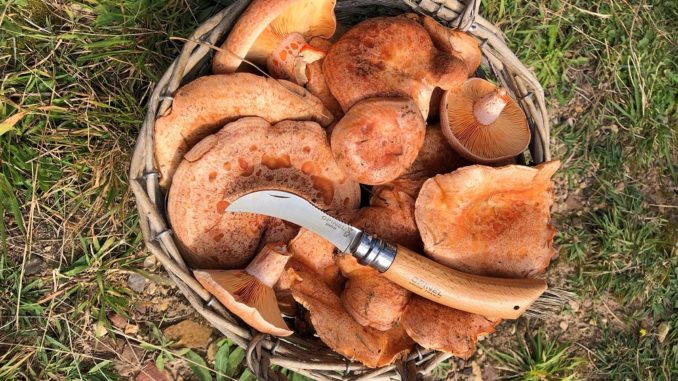
Mushrooming in the pine forests of New South Wales
Wood, forests and parks are about the only places left these days where we can get a dose of fresh air. For now anyway….
It’s autumn and the mushroom gathering season has begun. Some call the activity mushrooming, others like to be hip and shorten it to shrooming. Take your pick – and by the way – carry a good knife.
Last April I found an old wicker basket at home, took a steak knife out of the cutlery drawer, dislodged my $10 floral gumboots from a dark corner of my wardrobe, hopped in the car and drove to Oberon. I was heading to the Field to Forest Festival.
The event I attended at Oberon’s community hall was a gathering of locals and city slickers from Sydney keen to hear the dos and don’ts of forest foraging. Some people had been mushrooming before and were at the free event to collect pamphlets on what to pick and what to leave alone, and others were newcomers like me.
I didn’t even know you could head into the woods and pick mushrooms – and for free.
However, European settlers – particularly the Polish and Italians – are mad for it and have been mushrooming for as many autumns as they’ve been in Australia. Gathering wild mushrooms is big in Europe and has become popular in North America, while we Aussies are slowly latching onto the idea.
Autumn is the season and the fungi sprout under the pine forests from around the end of February until the end of May. If it’s been a particularly dry summer, the crop is likely to be down. Australia had a terrible summer – drought and bushfires – but we’ve had some rain in the past months, so there are likely to be mushrooms out there.
While the second annual forest festival (which was to begin on April 1 and run for the whole month) has been cancelled, folks can still go down to the woods and pick edible mushrooms – as long as they are physically well and keep a safe distance from each other. However, this could change in this rapidly-changing world. So don’t take my word for it!
These woods are the pine forests of Oberon – radiata pine forests to be precise – that are planted by and belong to the state government, which fortunately allows folks to forage for free unless they are foraging for commercial reasons. People who are picking big quantities of the tasty Saffron Milk Caps and Slippery Jacks, with the intention of selling them at markets or through other outlets, need a permit. There are 40,000 hectares of state-owned forests in Oberon alone, namely the Hampton, Jenolan and Vulcan state forests. There are other accessible forests in the Southern Highlands – Penrose State Forest is the main one – and others in Victoria and Tasmania. Here’s a look at the two edible fungi found in these forests.
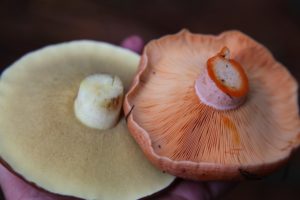
I met mushroom maestro Diego Bonetto at the Oberon workshop. What Diego, who hails from northern Italy where he grew up on a dairy farm, doesn’t know about mushrooms isn’t worth knowing. He lives and breathes the fabulous fungi and all forms of foraging and has been taking groups into the pine forests on gathering tours for years.
His CV tells me he’s also something of an actor, which is not surprising when you hear him talk with great passion, view his gesticulations as he pooh-poohs many fungi and foraging theories with gusto, and watch him cook up a mini-mushroom storm right in the forest while slurping in lots of oil and garlic.
Naturally, he is an environmentalist. He loves the land – “you must respect the land” is his mantra – and he certainly doesn’t take any more than he needs from the forest and suggests we don’t either. Not only does he forage for fungi but on other expeditions, he collects wild herbs and other edible natural flora, which most of us view as weeds.
He reminds me of one of my tennis companions, a Chinese lady who is often seen snipping wild dandelions at the courts at Cooper Park post-game, with a view to adding to them to her homemade dumplings. Yes, folks, foragers are amongst us.
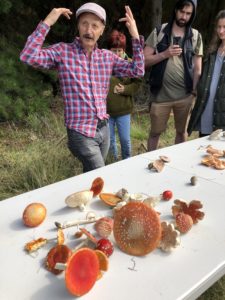
The seminar also introduced us to Col Roberts who owns a truffle farm or truffiere as they’re called. Truffles are also fungi, but unlike the pine mushroom that you can pick for free at your leisure, the very expensive black Perigord truffle just doesn’t spring up from the ground. It grows in a symbiotic relationship with certain trees, usually Oak, and its cultivation is quite an expensive exercise. Truffles are sniffed out by specially-trained dogs (pigs were used in the olden days in Europe). A truffle costs a lot of money, around $2-$3 a gram; a typical golfball-sized truffle weighs about 50 grams.
Col was an interesting speaker and although we visited his Lowes Mount Trufferie the next day, there were no truffles to be had as the precious black Perigords are not ready for harvest until winter. If life gets back to ‘normal’ by say July or August, Col may hold his regular truffle hunts this year. There you’ll meet his Labrador, Floyd, who sniffs out the black gold and later enjoy some of wife Sue’s goodies such as truffle honey.
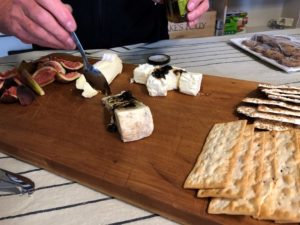
But back to the mushrooms.
Diego brought along a basket of mushrooms to the seminar; the good, the bad and the ugly of the species. We saw the rather beautiful Saffron Milk Caps, the brown-topped Slippery Jacks and a bunch of other mushrooms that grow in the woods but are definitive no-nos.
The most prolific of the offending mushrooms is the Amanita Muscaria (or fly agaric), a toadstool style mushroom, which is your classic fairy tale species. This red-capped beauty, covered in white dots, is quite pretty and is seen in a host of children’s storybooks. It’s certainly cute but if you eat an Amanita Muscaria you won’t die, but according to experts, you will go on a trip you really don’t want to go on (just saying now). The fungi are a hallucinogen/narcotic. Some people do eat them but only after they’ve parboiled them to get rid of the toxins, but really, who’d want to do that. They are best left alone and photographed in situ.
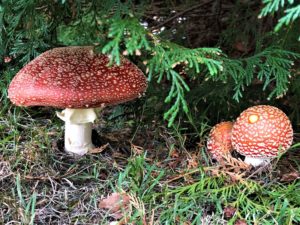
Fuelled with a whole bunch of facts and figures, I was ready for my first mushroom meetup, to take place at the Millionth Acre Recreation Area, in Hampton (about 26km east of Oberon on the road back to Sydney).
Here several folks had gathered on a pleasant autumn Sunday morning to get a hands-on taste of fungi foraging. I met Deigo again and after finding out who was actually in our group (a lot of independent people also turned up at the Hampton forest and wandered into the woods) we hopped back into our cars and followed him in convoy style into the forest; we travelled over bumpy roads more suited to 4WDs than my citified Holden Barina with its black pseudo racing stripe.
We stopped at a clearing where Diego had set up a table and his camp-style cooking equipment. Not all the foragers had been at the seminar the day before, so he showed them the good mushrooms and the ones to avoid and our group of 20 or so were ready to head out. Diego asked us to pick whatever fungi we saw, including the edible ones, the fairy tale toadstools and anything sprouting under the pines. We had 10 minutes to gather and regroup.
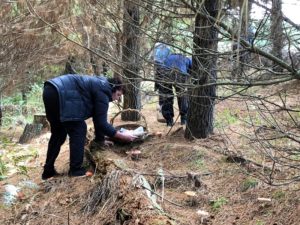
Once back at the clearing, Diego spread the ‘bounty’ onto the table and sorted them into the ‘yes’ and ‘no’ groups. Once we all knew what we were looking for, we were sent out again and given a good hour of fossicking in whatever part of the huge forest we wanted. Off I went and while I was rather mesmerised by the bright red and white tops of the lovely Amanita Muscaria, I just had to walk on by. Even though Diego told us that we’d soon develop “mushroom eyes” – the ability to spot a mushroom morsel at 20 paces – I didn’t have a lot of luck finding too many Saffrons or SJs. I did get a few, mind you, but I certainly didn’t harvest a hefty crop like others were gathering.
There was also the added drawback of leeches a-lurking; to be honest, I would never have thought of the pesky creatures had it not been for a nearby forager who had seen a couple and instantly freaked out. Then, well, I was not only on the lookout for Saffrons and Slipperies, but was scanning the pine-covered forest floor for the little bloodsuckers.
The hour went by in no time and on returning to the clearing, I was gob-smacked by some people’s baskets brimming with mushrooms; surely those folks were not novices like me?
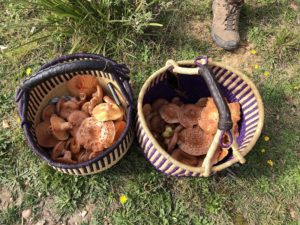
Meanwhile, Diego had turned up the gas on his portable stoves and set out his frypans. He took out the Slippery Jacks and Saffron Milk Caps he had prepared earlier and then fried them up (each type in a different frypan) and added a hefty dose of garlic.
Yep, finger-licking good. 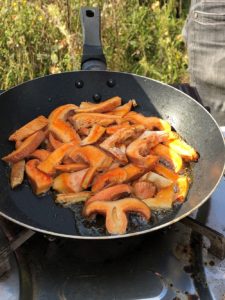
A sizzling pan of golden Saffron Milk Caps
We each scooped up spoonfuls and spread them on sourdough bread. I’d never tasted either variety before and found them delicious and just a little meaty; I think the Saffrons had the edge.
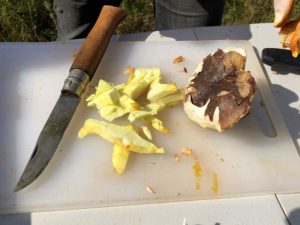
Diego recommended that folks who were taking home a big basketful should clean them first with a damp cloth, dry them, cook them and then divide them into groups to be frozen in freezer bags for eating later on. They keep that way for a few months.
I’ve never seen these varieties in my local Woollies and even at the trendy Harris Farm Market up the road from me, but I’m told that these gourmet beauties sell for $40 a kilo. Now that’s a good reason to head to Oberon.
However, I don’t want you to go to Oberon this year. But if you live nearby or near another pine forest you could take a stroll there on your own, or with a friend and while keeping a safe distance from your companion and with your mushroom eyes tuned to 20-20 vision, see what you can spy under the pine needles.
And with any luck, the organised mushroom hunts and the Field to Forest Festival will be on next year. Happy hunting!
Below are several websites that professionals and amateur foragers should find useful.
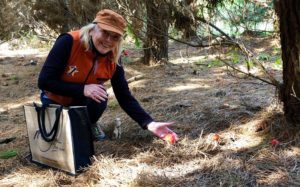
https://www.oberonaustralia.com.au/visitor-information/things-to-see-do/mushroom-picking/
https://www.forestrycorporation.com.au/visit/activities/mushrooming



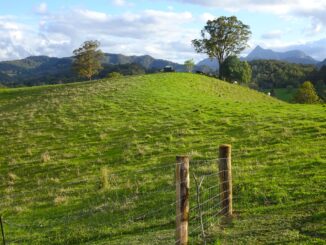
Cool to see your great Aussie story Caroline.
Thanks Robyn. Glad you enjoyed reading it.
cheers
Caroline
What a great way to spend a weekend in autumn. Let’s hope life gets back to normal in the months ahead.
Thanks Lesley. It really is great fun!
Like!! Great article post.Really thank you! Really Cool.
Thanks so much. Glad you enjoyed the story.
Great article!!!
Thanks Lyn. Glad you enjoyed it!